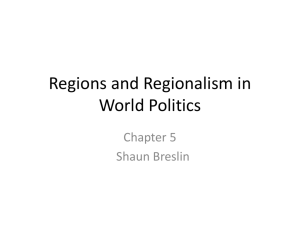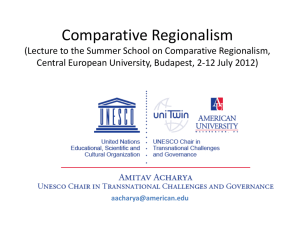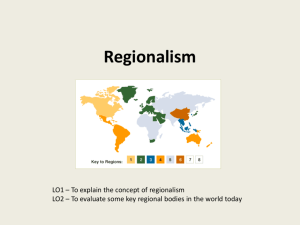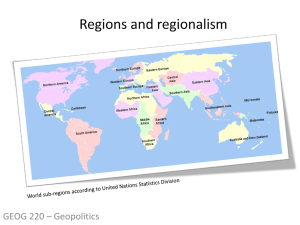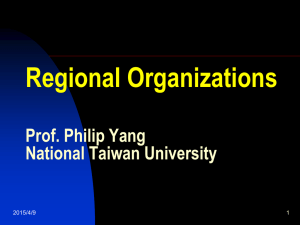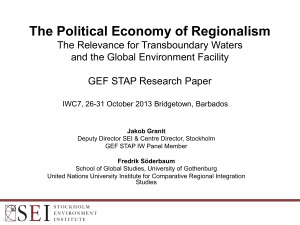Regions and Regionalism in World Politics
advertisement
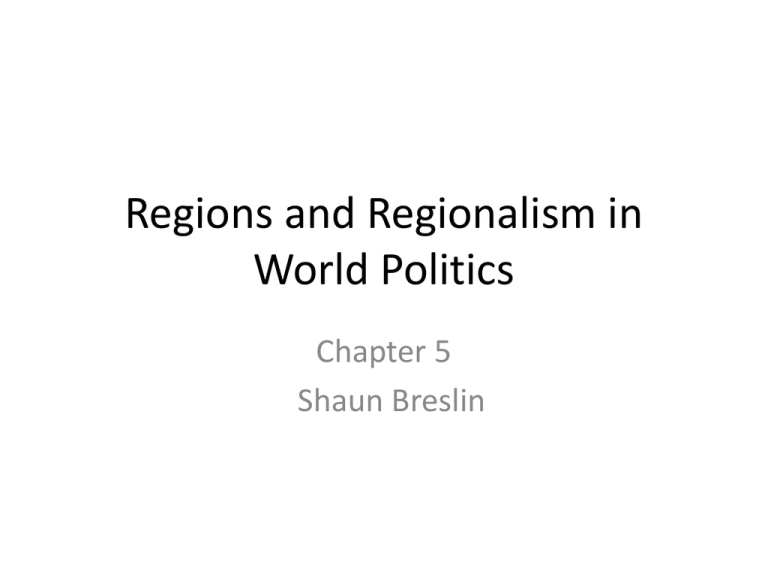
Regions and Regionalism in World Politics Chapter 5 Shaun Breslin Regionalism • Regionalism is the theory or practice of coordinating social, economic or political activities within a geographical region comprising a number of states. • On an institutional level, regionalism involves the growth of norms, rules and formal structures through which coordination is brought about. • It also implies a realignment of political identities and loyalties from the state to the region. • The extent of regional integration may range from cooperation amongst sovereign states on the basis of intergovernmentalism to the transfer of authority from states to central decision-making bodies, in accordance with supranationalism. (Heywood, 2011, p.482) Overview of major points • What drives regional processes forward? • What are the constraints that obstruct or slow down regional integration? • Implications of the rise and fall of the regions for individual states, the people of those states, and functioning of world politics. • To what extent development of a “regional identity” matter? • What regions mean for the future of the sovereign nation states? • Is it possible to build a national security through regional cooperation? European integration and the study of regions in world politics • Since 1980s, there have been increasing number of regional projects in world politics. • European experience of integration(as a continuing response to crisis) dominates many of the regionalism studies. Europe is the most studied and debated case. • Majority of the regionalism studies focus on institutions rather than processes because regionalism in Europe has been characterized by a high degree of institutionalization and the creation of formal regional bodies and entities( e.g. The European Community, the Euro, the European Parliament, and so on). How a region should be defined? • A region is often defined as a group of countries located in the same geographically specified area. • Exactly which areas constitute regions, however, remains controversial. Some observers, for example, consider Asia-Pacific a single region, others consider it an amalgamation of two regions, and still others consider it a combination of more than two regions. • Furthermore, a region implies more than just close physical proximity among the constituent states. The United States and Russia, for instance, are rarely considered inhabitants of the same region, even though Russia’s eastern coast is very close to Alaska. How a region should be defined? • Besides proximity, many scholars insist that members of a common region also share cultural, economic, linguistic, or political ties • Reflecting this position, Kym Anderson and Hege Norheim note that ‘‘while there is no ideal definition [of a region], pragmatism would suggest basing the definition on the major continents and subdividing them somewhat according to a combination of cultural, language, religious, and stage-of-development criteria.’ How a region should be defined? • Various studies, however, de. ne regions largely in terms of these nongeographic criteria and place relatively little emphasis on physical location. For example, France and the Francophone countries of Northwest Africa are often referred to as a regional grouping because of their linguistic similarities. Also, social constructivists have argued that countries sharing a communal identity comprise a region, regardless of their location. • In the latter vein, Peter J. Katzenstein maintains that regional ‘‘geographic designations are not ‘real,’ ‘natural,’ or ‘essential.’ They are socially constructed and politically contested and thus open to change.’’ Distinction Between Cooperation and Integration(I) • Functional Cooperation; limited arrangements between states for areas such as transportation, energy or health. • Economic Cooperation; arrangements that perceive some commercial preferentialism but with no harmonization of domestic rules or obligation to common action. • Political Cooperation; refers to the mutual support/commitment in the implementation of certain values and practices within the countries. E.g. Cooperation in Foreign and Security policy means that governments system inform/consult each other and try to adopt common position in international organization. Distinction Between Cooperation and Integration(II) None of these arrangements has any consequences for the international status of participating countries beyond normal obligations under international law. Distinction Between Cooperation and Integration(III) • integration may refer to: …the process of bringing together culturally and socially discrete groups into a single territorial unit and the establishment of a national identity Europe's Regionalism “The nation-state is too big to run everyday life, and too small to manage international affairs. So say many of Europe's regional and big-city leaders, who are themselves gaining influence and authority. European cities and regional governments are acquiring bigger budgets and developing more professional bureaucracies.” http://www.foreignaffairs.com/articles/52645/johnnewhouse/europes-rising-regionalism Dominance of Europe in shaping the main theories developed to explain regional integration processes • ASEAN(The Association of Southeast Asian Nations, 1967) for instance similarly expand to include former Communist party states but has more looser linkages than the more legally formalized European project. • “ASEAN way”; consensus building rather than formal rules. Seen as only a small part of a larger East Asian region. • Studies may overlook the significant integration practices across the globe while majorly focusing on European case. • There is much more to regional integration than just the European case. The study of regionalism in seven sub-groups: This typology provides a rough overview of the different ways in which regionalism impact on international politics today. (1) Theory building. A body of work which considers how we define a region, how and why regional integration takes place, what forces a region to cohere, consolidate/institutionalize and survive. It asks why it occurs in some places and not the others? (2) The Study of Europe. This body of work is more isolated sub-discipline even considered as EU studies sub-discipline. It includes theories of European integration, analyses of the consequences of regionalism, studies of the processes of EU policy-making, the relationship between the regional and national levels of governance and prospects for future integration. (3) Case-specific studies of individual regions. Seek to contribute to theory and comparative understandings, rather than simply being concerned with events in the region under discussion. The importance of dealing with non-traditional challanges to security has an increasingly strong focus(the environment, infectious diseases, movement of people, drug trafficking, and so on.) (4) Comparative studies of different regional processes. Focuses on different types or levels of institutionalization of regional cooperation. At most of the time the EU taken to be the constant against which other regional forms are compared. Non-European regions are much more rarely compared to each other. (5)The relationship between regionalism and world order. The main focus of these studies is the relationship between regionalism and global multilateralism. Are they providing us global solutions through regional free trade arrangements and global free trade agendas. (6) Regions as actors in international relations. Deals with how regions can develop and promote a common/single interest in international relations-the ‘actorness’ of regions. For example, through adopting a single EU position in trade negotiations, the EU as a single body would enhance its actorness. (7) Regions and security. Ensuring security was a key impulse in European integration. To what extent economic interactions decrease the possibility of conflict? Thus security issues have always been at the heart of theories and processes of regional integration. Identifying Regions • Continents are formed by nature, regions are formed by people; they are politically and socially constructed. They change over time. The focus of their activities is the main reference point while defining a “region”. Examples for different conceptions of region; America NAFTA, North American Free Trade Agreement Since it was a trade agreement it includes Mexico because of its position as a major producer for goods fo the US market. Mexico can be considered as a part of ‘Latin America’ in terms of culture and a history of Spanish colonization, or part of ‘Central America’ in terms of the population settelment. Asia East Asian Summit[ includes India and Australasia] ASEAN plus China, Japan, South Korea[ excludes India and Australasia] Asia Pacific Economic Cooperation (APEC)[ excludes India, includes US, Canada since they have a Pacific Coastline] Regional Identities • Both regional identities and regional formations are fluid. For instance, what is Europe or who is European does not have to be defined by membership of the EU. • Feeling of being part of the region, sense of belonging makes the regional sphere of governance legitimate. • Regional identity is essential for the transition from national to regional levels of political activity. Which one is cause, which one is effect? Does the existence of a shared identity lead to people coming together in a shared regional effort? (OR) Does the creation of a region for other reasons(establishing common laws and borders, facilitating the flow of goods and people) leads to the emergence of a regional identity? References • Heywood, Andrew, Global Politics, Palgrave Macmillan, 2011 • Weiner, Myron (1965): “Political Integration and Political Development”, Annals of the American Academy of Political and Social Science, Vol. 358, Mar


